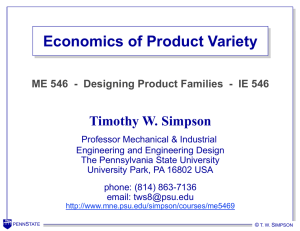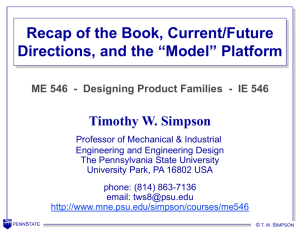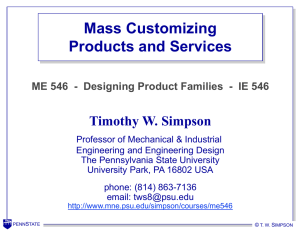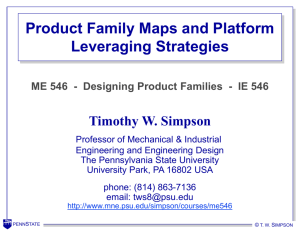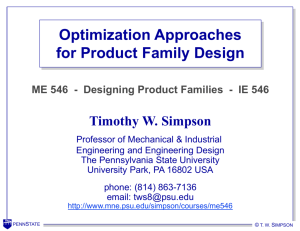PPT
advertisement
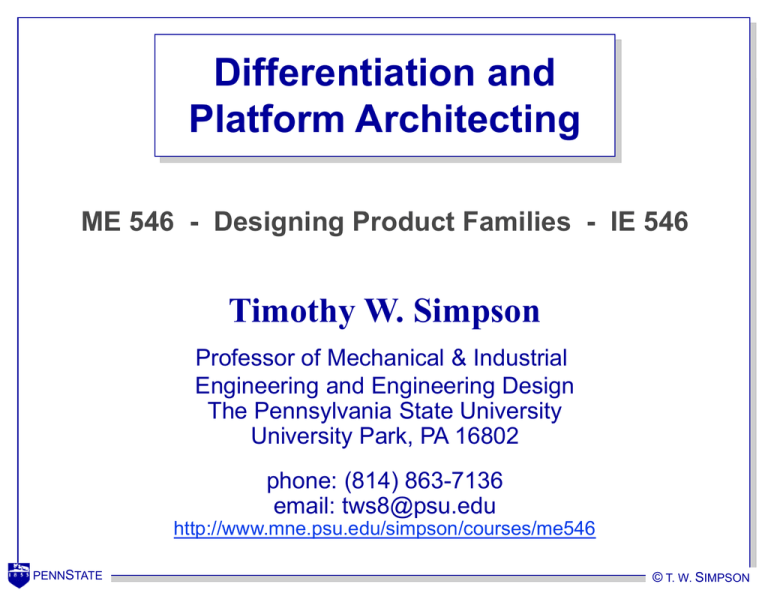
Differentiation and Platform Architecting ME 546 - Designing Product Families - IE 546 Timothy W. Simpson Professor of Mechanical & Industrial Engineering and Engineering Design The Pennsylvania State University University Park, PA 16802 phone: (814) 863-7136 email: tws8@psu.edu http://www.mne.psu.edu/simpson/courses/me546 PENNSTATE © T. W. SIMPSON Planning Product Platforms • Robertson and Ulrich (1998) advocate a three-step approach: 1) Product plan – which products to offer when 2) Differentiation plan – how products will be differentiated 3) Commonality plan – which components/modules will be shared Source: D. Robertson and K. Ulrich, 1998, "Planning Product Platforms," Sloan Management Review, 39(4), pp. 19-31. PENNSTATE © T. W. SIMPSON Differentiation Plan for automotive example Commonality Plan for automotive example Commonality Plan and Differentiation Plan Source: D. Robertson and K. Ulrich, 1998, "Planning Product Platforms," Sloan Management Review, 39(4), pp. 19-31. PENNSTATE © T. W. SIMPSON Product Family Architecting • Based on the commonality plan and differentiation plan, an architecture must be developed for the platform and family of products If everything is the same, then nothing is different despite cost savings If everything is different, then costs skyrocket • Trick: how to find the best architecture to balance the two Source: D. Robertson and K. Ulrich, 1998, "Planning Product Platforms," Sloan Management Review, 39(4), pp. 19-31. PENNSTATE © T. W. SIMPSON Platform Architecting • The platform architecture will lead to a product family with a given level of commonality and distinctiveness Option A has low commonality but each product is very distinctive Option B has high commonality but products lack distinctiveness Option C has a good balance of commonality and distinctiveness PENNSTATE C A B © T. W. SIMPSON Commonality/Variety Tradeoff Angle • Within a given industry do companies tend to apply the same strategy: do they have the same trade-off angle, a, between commonality C and variety? A • X. Ye & J. Gershenson (Michigan Tech) argue that they do and have created the Product Family Evaluation Graph (PFEG) based on this idea to provide guidance for companies in product family design PENNSTATE a a B a © T. W. SIMPSON Product Family Evaluation Graph (Ye, 2008) • Compares alternative product families to determine which family best meets a company’s strategic goals Also good for product family benchmarking • The tradeoff angle, a, is dictated by strategic impact factors and a company’s competitive focus ideal target realistic goal for company PENNSTATE actual target tradeoff © T. W. SIMPSON Strategic Impact Factors – Marketing PENNSTATE © T. W. SIMPSON Strategic Impact Factors: Others n • Each factor is scored and weighted: S (wi I f ) i 1 and a is computed: a f S i PENNSTATE © T. W. SIMPSON ecker Power Tool Case Study • Imagine you are designing Delta’s new power toolset • The competition is existing toolsets made by: DEWALT® ® ® DEWALT Skil PENNSTATE Black & Decker wi Skil® I fi Si wi Delta® I fi Si 6 -1 -6 3 -1 -3 3 -1 -3 6 -1 -6 Customer needs characteristics 1 -1 -1 1 -1 -1 1 -1 -1 1 -1 -1 Customer needs Price consciousness Quality consciousness 3 3 9 -1 -1 1 -3 -3 9 3 3 9 -1 -1 1 -3 -3 9 3 9 9 -1 -1 1 -3 -9 9 3 9 9 -1 -1 1 -3 -9 9 Level of pre- and post sales service 6 1 6 6 1 6 6 1 6 6 1 6 Buyer power Competitive intensity 9 6 1 1 9 6 6 9 1 1 6 9 6 6 1 1 6 6 3 6 1 1 3 6 Unique sets of customer requirements 1 -1 -1 1 -1 -1 1 -1 -1 3 -1 -3 Development time 6 -1 -6 3 -1 -3 3 -1 -3 6 -1 -6 Product life-cycle length and predictability 1 -1 -1 1 -1 -1 1 -1 -1 1 -1 -1 Maintenance and service Automation level Recycling Financial condition 3 1 6 9 -1 -1 -1 1 -3 -1 -6 9 3 1 1 6 -1 -1 -1 1 -3 -1 -1 6 3 1 3 6 -1 -1 -1 1 -3 -1 -3 6 3 3 1 6 -1 -1 0 1 -3 -3 0 6 Distribution and supply channel 3 -1 -3 3 -1 -3 3 -1 -3 3 -1 -3 SumDecker = Black & ® Dewalt® wi I fi Si Stability and predictability of demand levels ® Black & Deck® wi I fi Si Factor ® ® 5 Skil Competitors Black and Decker® ® DEWALT ® ® Skil Skil 13 2 ac CDIC CDIV 0.424 0.324 0.438 0.576 53.67° 0.676 64.42° 0.562 52.10° -8 S 5 13 2 © T. W. SIMPSON Determining a for Delta – Ideal vs. Actual • Use linear regression to correlate S and a based on competition 65 60 DEWALT® Delta CDIC CDIV a actual a ideal 0.22 0.78 ® 74.3° 39.6° 55 ac Black and Decker® Skil® CDIV 50 45 1 40 0.78 FDelta FDelta ® ® 35 -10 -5 0 S 5 10 15 PDelta , 39.6° ® Company ® Delta PENNSTATE S target -8 a b a 1.17 48.95 39.61° a = -8×1.17+48.95 = 39.61 Pˆa 74.3 39.6° 0 0.22 74.3° 39.61 1 CDIC © T. W. SIMPSON PFEG Discussion • Why the differences between estimated and actual? • How else could we use PFEG? • What do you think about the underlying assumption, i.e., companies within a given industry tend to use a similar commonality/variety strategy? PENNSTATE © T. W. SIMPSON Factors Affecting Platform Architecture • • • • • • • • • • • • • • • • • • Customer requirements Changing performance needs (including size, style, weight, etc.) New environmental constraints (temperature, humidity, vibration, etc.) New functions (due to new markets or new enabling technologies) Reliability improvements Reduce prices (cost reductions required) Reduce amount of material Change material type Remove redundant components Reduce assembly time Use lower cost technology Reduce serviceability requirements Reduce serviceability time Improve component manufacturing process Regulations, standards, and so on Changing government/industry regulations or standards Competitor introduction of improved product (higher quality or lower price) Obsolescence of parts Source: Martin, M. V. and Ishii, K., 2002, "Design for Variety: Developing Standardized and Modularized Product Platform Architectures," Research in Engineering Design, 13(4), pp. 213-235. PENNSTATE © T. W. SIMPSON Generational Variety Index • GVI is an indicator of the amount of redesign required for a component to meet future market requirements • Process for calculating GVI: Step 1: Determine market & desired life for platform Step 2: Create QFD matrix Step 4: Estimate engineering metric target values Step 3: List expected changes in customer requirements Step 5: Calculate normalized target values matrix Step 6: Create GVI matrix Step 7: Calculate GVI Source: Martin, M. V. and Ishii, K., 2002, "Design for Variety: Developing Standardized and Modularized Product Platform Architectures," Research in Engineering Design, 13(4), pp. 213-235. PENNSTATE © T. W. SIMPSON What is Quality Function Deployment (QFD)? • Developed by Japanese in 1970’s to provide a way to propagate customer needs through product, part, and process quality requirements using a series of maps House of Quality helps translate “Voice of the Customer” into specific engineering requirements Source: J. R. Hauser and D. Clausing, 1998, "The House of Quality," Harvard Business Review, 66(3), pp. 63-73. PENNSTATE © T. W. SIMPSON Customer Attributes Engineering Characteristics Source: J. R. Hauser and D. Clausing, 1998, "The House of Quality," Harvard Business Review, 66(3), pp. 63-73. PENNSTATE © T. W. SIMPSON House of Quality (HOQ) Source: J. R. Hauser and D. Clausing, 1998, "The House of Quality," Harvard Business Review, 66(3), pp. 63-73. The “roof” identifies any relationships between the Engineering Requirements The “basement” identifies specific targets for each Engineering Requirement PENNSTATE © T. W. SIMPSON Generational Variety Index • GVI is an indicator of the amount of redesign required for a component to meet future market requirements • Process for calculating GVI: Step 1: Determine market & desired life for platform Step 2: Create QFD matrix Step 4: Estimate engineering metric target values Step 3: List expected changes in customer requirements Step 5: Calculate normalized target values matrix Step 6: Create GVI matrix Step 7: Calculate GVI Source: Martin, M. V. and Ishii, K., 2002, "Design for Variety: Developing Standardized and Modularized Product Platform Architectures," Research in Engineering Design, 13(4), pp. 213-235. PENNSTATE © T. W. SIMPSON Example of GVI Computation Expected range of change over platform life MTBF (hrs) Volume flow rate (gal/min) Depth (in) Height (in) Width (in) Power consumption (W) Cold water volume (gal) Cost ($) Fast cool down Cold water High capacity Low energy usage Compact Fill cup quickly Reliable Low cost EM Target Values Current Market Future Market 1 Future Market 2 Future Market 3 Water Temperature (C) Cool down time (min) • Consider the design of a water cooler for current and three future markets: x M L M M L M L M 100 100 125 80 Sep-00 Jun-01 Oct-01 Apr-02 x x x x x x x x x 120 120 90 120 10 10 10 10 0.5 0.5 0.8 0.5 75 12.5 13 50 12.5 13 75 12.5 13 75 10 13 13 13 13 10 0.5 0.5 0.8 0.5 15,000 15,000 15,000 15,000 Water bottle Reservoir Insulation T Heat E sink Fan C Power supply Water Cooler Chassis (side view) Source: Martin, M. V. and Ishii, K., 2002, "Design for Variety: Developing Standardized and Modularized Product Platform Architectures," Research in Engineering Design, 13(4), pp. 213-235. PENNSTATE © T. W. SIMPSON GVI Matrices PENNSTATE x x x x x x x Fascia 1 Insulation 3 Reservoir 6 Plumbing Power Supply 3 6 1 6 9 1 4 1 7 3 3 6 1 5 Fascia x Insulation x Reservoir Power Supply x Plumbing Thermo-Elec Cooler x Chassis Heat Sink Cool down time (min) Water Temperature (C) Cold water volume (gal) Power consumption (W) Width (in) Height (in) Depth (in) Volume flow rate (gal/min) MTBF (hrs) Cost ($) x x x x x x x x x x x x x x x x x x GVI Ratings Chassis Thermo-Elec Cooler x Engineering Requirements Components Fan Cost ($) MTBF (hrs) Volume flow rate (gal/min) Depth (in) Height (in) Width (in) Cold water volume (gal) Water Temperature (C) x GVI Matrix Cool down time (min) Water Temperature (C) Cold water volume (gal) Power consumption (W) Width (in) Height (in) Depth (in) Volume flow rate (gal/min) MTBF (hrs) Cost ($) GVI: QFD Matrix II x Heat Sink Fast cool down Cold water High capacity Low energy usage Compact Fill cup quickly Reliable Low cost Fan Customer Requirements Cool down time (min) QFD Matrix I Power consumption (W) Engineering Requirements 6 6 6 6 3 15 9 1 9 3 19 1 6 24 Rating Description Requires major redesign of the component 9 (>50% of initial redesign costs) 6 Requires partial redesign of component (<50%) 3 Requires numerous simple changes (<30%) 1 Requires few minor changes (<15%) 0 No changes required Note: Elements with higher GVI values will require most redesign for future markets; so, platform low GVI elements and embed flexibility into/for high GVI elements © T. W. SIMPSON
